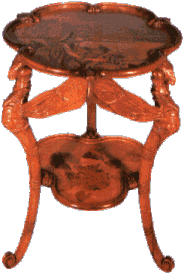
A fruitwood and marquetry two-tier table by Emile Gallé
l895;ht 30in/76cm; value code A
FURNITURE
THE NANCY SCHOOL 1:
EMILE GALLÉ

A fruitwood and marquetry two-tier table by Emile Gallé
l895;ht 30in/76cm; value code A
1. Does the piece have a sculptural quality?
2. Is it hand-made?
3. Are structural elements, such as supports, largely organic, zoomorphic or naturalistic?
4. Does the piece have a subtle marquetry signature?
5. Is the wood fruitwood or exotic?
6. Does decoration include inlay work of fine quality marquetry on the back and sides as
well as at the front?
7. Do any marquetry panels depict asymmetrical motifs?
8. Is the form symmetrical and highly inventive?
9. Do top rails and rims feature openwork relief carving?
The Nancy School
Gallé was the principal force in a group of French Art Nouveau artists and
designers working in and around Nancy. On his initiative they formed a school c.1890, to
promote naturalism in design. Members included the Daum brothers (see here) and Louis Majorelle (see here).
| Emile Gallé (French, 1846-1904) Known equally for his exquisite glasswares (see here). Emile Gallé's furniture is considered to be pure Art Nouveau. His inventive furniture designs heralded the rise of more floral decorative forms. He drew his inspiration from nature, particularly the flora and fauna of his native Lorraine. Gallé's work also Ied to a revival of marquetry. Gallé's furniture Gallé treated wood as a plastic medium, and did not try to follow the grain. His designs have a sculptural quality, as in the legs of the table in the main picture, which combine plant and animal forms, and show Gallé's fondness for dragonfly motifs. The tiers feature inlaid flowers and leaves. * Designs include occasional furniture, as well as dining and bedroom suites. Some pieces are inlaid with verses (see here). Gallé produced some novelty forms, such as the music stand, above,
which adapted elements from other designs. This piece, from c.1900, is reminiscent of a
Regency chiffonier, although it contains innovative variations that give it a strikingly
original appearance. Characteristically, decoration appears on the sides and back as well
as on the front. The quality of the fruitwood marquetry rivals that of the 18thC ébénistes.
The motifs, of flowers and butterflies, are typical. |
The form of the mahogany vitrine above, is simple, with emphasis
on the inlaid and carved decoration, which itself is restrained. The shelves are
undecorated. Larger pieces such as this (62in/159cm in height) generally command higher
prices. |